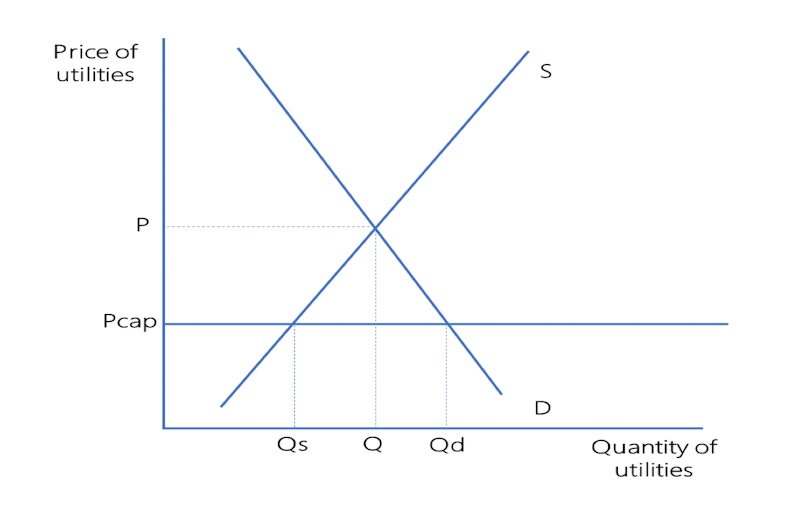Exam Support
Government Intervention to Protect Consumers in Utilities Markets (Worked Answer to Edexcel Q6 (e), Paper 1 2019)
- Level:
- A-Level
- Board:
- Edexcel
Last updated 5 Jan 2020
Here is an example answer to a 15-mark question for Edexcel A-Level Economics on methods of government intervention to protect consumers within the utilities markets.
[Note: Examiner Commentary is provided in square brackets / bold / italics]
___________________________________________
Price capping is one method of protecting consumers because it effectively sets a maximum price on the sale of a particular good to consumers. In the case of energy, it is vitally important to make sure that people don’t pay too high a price for energy because it is a critical for things like heating and cooking. Low-income families run a real risk of freezing to death if the price of gas is too high. The diagram below shows how the imposition of maximum price will drive the price below the market equilibrium and make it more affordable to consumers.

[Candidates were able to choose any appropriate policy to discuss. In this case, it is clear that the policy being discussed is price capping.The candidate’s link to the real-world (i.e. freezing to death) is helpful for demonstrating that they have applied their theory to the specific context given. The labels on the diagram also help with this.]
However, price-capping is undesirable from a firm’s point of view. Firms like EON believe that it may reduce innovation. This is because the new ‘maximum price’ will be unable to cover the firm’s marginal costs beyond Q2. As a result, the firm sees fewer sales and lower profit, which can be reinvested into R&D. Furthermore, gas companies will often claim that price-capping will lead to shortages as the price no longer covers production to its former level (Qe) and only Q2 and be produced – thereby leading to a shortage. Ultimately, the shortage and the lack of investment could worsen utility provision for consumers, and potentially be an example of government failure.
[The link to the context of energy companies in the evaluation is very good.]
Another method of Government intervention is to prevent monopolies from emerging and encouraging competition. In the case of gas, there is the established Big Six (an oligopoly) and, in the case of telecoms, BT has 35% market share, and so has monopoly power. Therefore, the Government should be looking at ways to reduce barriers to entry and increase the number of firms in the market. This will reduce the price setting power that dominant firms have and should increase dynamic efficiency within the market. This can reduce prices for consumers and improve the quality of the service that they receive. The Government could have rejected BT’s planned takeover of EE. Similarly, they could be giving tax breaks (or subsidies) to smaller suppliers such as First Utility to help them compete.
On the other hand, many utility markets are natural monopolies. This means that the market is best served by one firm – often because the economies of scale are so large that only one firm could feasibly achieve them all (or get close). The gas market, where there is only one gas-pipe delivery system, is a good example. Having too many firms in this market will mean that no firm can achieve large-scale economies of scale which means that consumers won’t actually benefit from the lower prices that a natural monopoly could give them.
[Structurally, this is an easy answer to mark – the candidate clearly identifies a second policy here. The link to the data and context is excellent, as is the focus on protecting consumer interests.]
Essential Revision Resources for Edexcel A-Level Economics
-
22
Student Workbooks for A-Level & GCSE Economics
Resource Collection
-
7
Revision Flashcards for A-Level Economics Students
Resource Collection
You might also like
Understanding command words in exam questions
Exam Support
AS Micro Multiple Choice: Business Objectives
Exam Support
AS Micro Multiple Choice: Price Elasticity of Supply
Exam Support